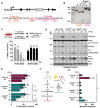Cell Type Specific Suppression of Hyper-Recombination by Human RAD18 Is Linked to Proliferating Cell Nuclear Antigen K164 Ubiquitination
- PMID: 39858544
- PMCID: PMC11763143
- DOI: 10.3390/biom15010150
Cell Type Specific Suppression of Hyper-Recombination by Human RAD18 Is Linked to Proliferating Cell Nuclear Antigen K164 Ubiquitination
Abstract
RAD18 is a conserved eukaryotic E3 ubiquitin ligase that promotes genome stability through multiple pathways. One of these is gap-filling DNA synthesis at active replication forks and in post-replicative DNA. RAD18 also regulates homologous recombination (HR) repair of DNA breaks; however, the current literature describing the contribution of RAD18 to HR in mammalian systems has not reached a consensus. To investigate this, we examined three independent RAD18-null human cell lines. Our analyses found that loss of RAD18 in HCT116, but neither hTERT RPE-1 nor DLD1 cell lines, resulted in elevated sister chromatid exchange, gene conversion, and gene targeting, i.e., HCT116 mutants were hyper-recombinogenic (hyper-rec). Interestingly, these phenotypes were linked to RAD18's role in PCNA K164 ubiquitination, as HCT116 PCNAK164R/+ mutants were also hyper-rec, consistent with previous studies in rad18-/- and pcnaK164R avian DT40 cells. Importantly, the knockdown of UBC9 to prevent PCNA K164 SUMOylation did not affect hyper-recombination, strengthening the link between increased recombination and RAD18-catalyzed PCNA K164 ubiquitination, but not K164 SUMOylation. We propose that the hierarchy of post-replicative repair and HR, intrinsic to each cell type, dictates whether RAD18 is required for suppression of hyper-recombination and that this function is linked to PCNA K164 ubiquitination.
Keywords: PCNA K164; RAD18; gap-filling; hyper-recombination; ubiquitination.
Conflict of interest statement
A.K.B. is a member of the editorial board of
Figures






Update of
-
Cell type specific suppression of hyper-recombination by human RAD18 is linked to PCNA K164 ubiquitination.bioRxiv [Preprint]. 2024 Sep 3:2024.09.03.611050. doi: 10.1101/2024.09.03.611050. bioRxiv. 2024. Update in: Biomolecules. 2025 Jan 20;15(1):150. doi: 10.3390/biom15010150. PMID: 39282285 Free PMC article. Updated. Preprint.
References
MeSH terms
Substances
Grants and funding
LinkOut - more resources
Full Text Sources
Research Materials
Miscellaneous

